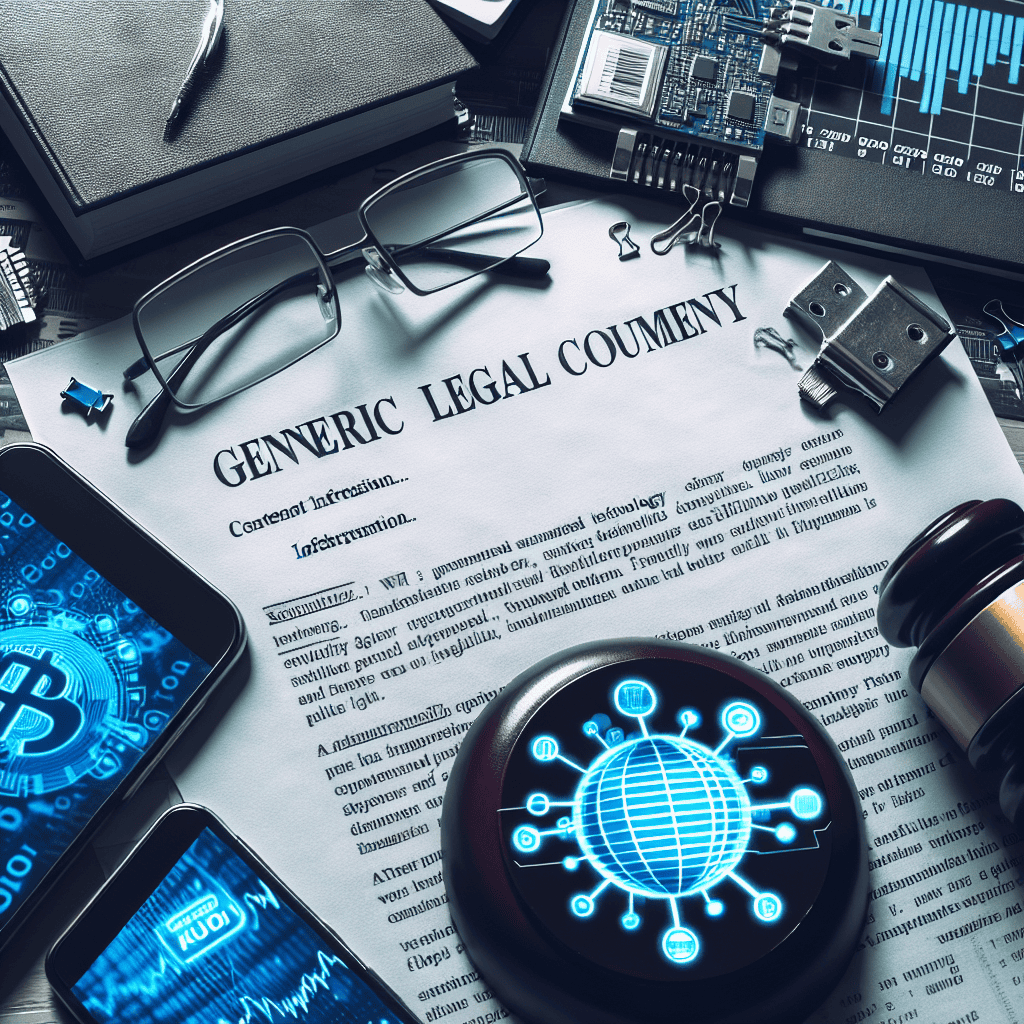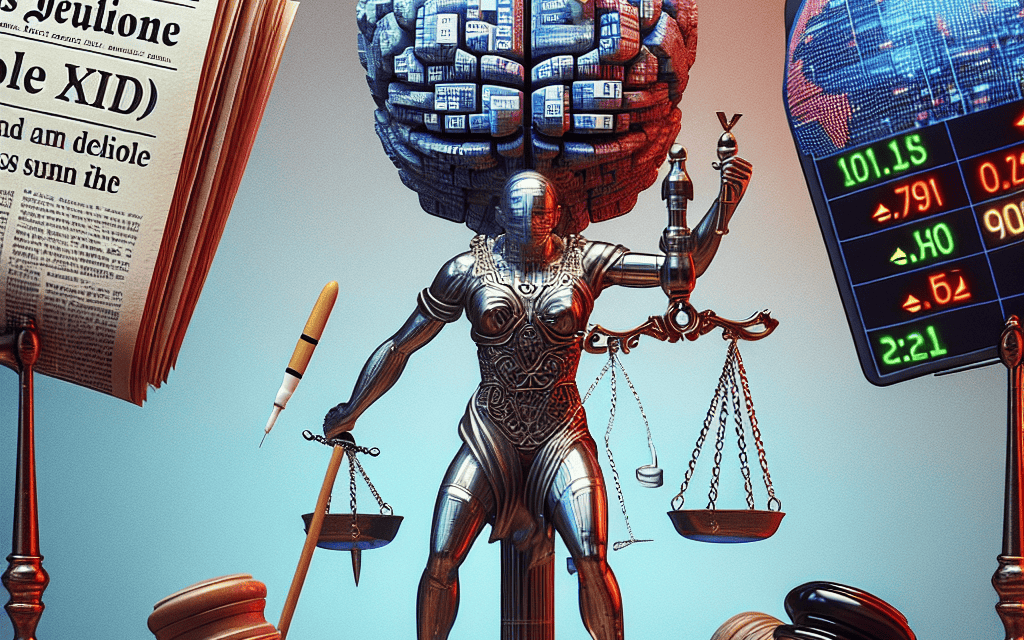“Media Giants Clash with AI: Dow Jones and New York Post Sue Perplexity for Content Breach”
Introduction
In a significant legal development, Dow Jones and the New York Post have filed a lawsuit against Perplexity AI, alleging content infringement. The lawsuit claims that Perplexity AI has unlawfully utilized proprietary content from these established media entities without proper authorization, thereby violating intellectual property rights. This case underscores the growing tensions between traditional media companies and emerging AI technologies, as the latter increasingly rely on existing content to train and develop their models. The outcome of this lawsuit could have far-reaching implications for the relationship between AI developers and content creators, potentially setting new precedents for how intellectual property laws are applied in the digital age.
Legal Implications of Content Infringement in the Digital Age
In the rapidly evolving digital landscape, the intersection of technology and intellectual property rights has become a focal point of legal discourse. Recently, this intersection was brought into sharp relief when Dow Jones and the New York Post filed a lawsuit against Perplexity AI, alleging content infringement. This case underscores the complex legal implications of content use in the digital age, where artificial intelligence technologies are increasingly capable of generating and distributing vast amounts of information. As we delve into the intricacies of this lawsuit, it is essential to understand the broader context of intellectual property rights and the challenges posed by AI-driven content creation.
The lawsuit filed by Dow Jones and the New York Post centers on the claim that Perplexity AI has unlawfully used their proprietary content. This raises significant questions about the extent to which AI systems can utilize existing content without infringing on intellectual property rights. In the digital age, where information is both a commodity and a tool, the boundaries of content ownership are continually tested. The plaintiffs argue that Perplexity AI’s use of their content constitutes a violation of copyright laws, which are designed to protect the original works of authors and creators from unauthorized use.
Transitioning to the legal framework, copyright law is a cornerstone of intellectual property rights, providing creators with exclusive rights to their works. However, the advent of AI technologies has complicated the enforcement of these rights. AI systems, such as those developed by Perplexity AI, are capable of processing and generating content at an unprecedented scale, often blurring the lines between original creation and derivative work. This capability challenges traditional notions of authorship and ownership, prompting legal experts to reevaluate existing frameworks to accommodate the unique characteristics of AI-generated content.
Moreover, the lawsuit highlights the tension between innovation and regulation. On one hand, AI technologies hold immense potential for advancing knowledge and driving economic growth. On the other hand, they pose significant risks to the protection of intellectual property, necessitating a careful balance between fostering innovation and safeguarding creators’ rights. As the legal battle unfolds, it will likely set important precedents for how AI-generated content is treated under copyright law, influencing future cases and legislative developments.
Furthermore, this case exemplifies the broader trend of increasing litigation in the digital realm, as companies seek to protect their intellectual assets from perceived threats posed by new technologies. The outcome of this lawsuit could have far-reaching implications for businesses and content creators, shaping the strategies they employ to protect their intellectual property in an era where digital content is both ubiquitous and easily replicable.
In conclusion, the lawsuit filed by Dow Jones and the New York Post against Perplexity AI serves as a critical case study in the legal implications of content infringement in the digital age. It underscores the challenges posed by AI technologies to traditional intellectual property frameworks and highlights the need for a nuanced approach to balancing innovation with regulation. As the digital landscape continues to evolve, it is imperative for legal systems to adapt, ensuring that the rights of creators are protected while allowing for the continued advancement of technology. This case will undoubtedly contribute to the ongoing dialogue on how best to achieve this balance, shaping the future of intellectual property law in the digital age.
The Role of AI in Content Creation and Copyright Challenges
The rapid advancement of artificial intelligence has significantly transformed various industries, with content creation being one of the most impacted sectors. As AI technologies continue to evolve, they offer unprecedented opportunities for generating and distributing content at scale. However, these advancements also bring forth complex challenges, particularly in the realm of copyright and intellectual property rights. A recent lawsuit filed by Dow Jones and the New York Post against Perplexity AI underscores the growing tension between AI-driven content creation and traditional media entities.
Perplexity AI, a company known for its sophisticated AI models capable of generating human-like text, has been accused of content infringement by these prominent media organizations. The lawsuit alleges that Perplexity AI’s technology unlawfully reproduces and distributes content originally produced by Dow Jones and the New York Post without proper authorization or compensation. This legal action highlights the intricate balance between leveraging AI for innovative content solutions and respecting the intellectual property rights of original content creators.
The core of the dispute lies in the way AI models are trained and how they generate content. AI systems, such as those developed by Perplexity AI, are typically trained on vast datasets that include a wide array of publicly available information. While this approach enables AI to produce coherent and contextually relevant content, it also raises questions about the ownership of the material used in training these models. The lawsuit argues that by using proprietary content from Dow Jones and the New York Post, Perplexity AI has crossed the line from fair use into infringement.
This case is emblematic of the broader challenges faced by the media industry as it grapples with the implications of AI-driven content creation. On one hand, AI offers media companies the potential to enhance productivity, streamline operations, and even personalize content for audiences. On the other hand, it poses a threat to the traditional business models that rely on the protection of intellectual property. As AI continues to blur the lines between original and generated content, media companies are increasingly concerned about the potential erosion of their competitive advantage and revenue streams.
Moreover, this lawsuit could set a precedent for how copyright laws are applied to AI-generated content. The outcome may influence future legal frameworks and guidelines, shaping the way AI technologies are developed and deployed in the content creation space. It also raises important ethical considerations about the responsibility of AI developers to ensure that their technologies do not infringe upon the rights of others.
In navigating these challenges, collaboration between AI developers and content creators is crucial. Establishing clear guidelines and frameworks for the ethical use of AI in content creation can help mitigate potential conflicts and foster a more harmonious relationship between technology and media. Additionally, ongoing dialogue between stakeholders can lead to innovative solutions that respect intellectual property rights while embracing the benefits of AI.
As the lawsuit between Dow Jones, the New York Post, and Perplexity AI unfolds, it serves as a reminder of the complex interplay between technology and law. The resolution of this case will likely have far-reaching implications for the future of AI in content creation, influencing how media companies and AI developers approach the delicate balance between innovation and intellectual property rights. As such, it is a pivotal moment for both industries, highlighting the need for thoughtful consideration and proactive measures to address the challenges posed by AI-driven content creation.
Analyzing the Dow Jones and New York Post Lawsuit Against Perplexity AI
In a significant development within the realm of artificial intelligence and media, Dow Jones and the New York Post have initiated legal proceedings against Perplexity AI, alleging content infringement. This lawsuit underscores the growing tension between traditional media companies and emerging AI technologies, as the latter increasingly encroach upon the domains traditionally dominated by the former. The plaintiffs, Dow Jones and the New York Post, assert that Perplexity AI has unlawfully utilized their proprietary content, thereby infringing upon their intellectual property rights. This case highlights the complex interplay between innovation and regulation, as well as the challenges faced by legacy media in adapting to the rapidly evolving digital landscape.
At the heart of the lawsuit is the allegation that Perplexity AI, a company specializing in AI-driven content generation, has been using algorithms to scrape and repurpose content from the plaintiffs’ publications without proper authorization. This practice, according to the plaintiffs, not only violates copyright laws but also undermines the economic value of their original content. As media companies increasingly rely on digital subscriptions and online advertising for revenue, the unauthorized use of their content by AI entities poses a direct threat to their financial sustainability. Consequently, this lawsuit is not merely a legal battle but also a strategic move to protect their business interests in an era where content is both king and currency.
Moreover, this case raises broader questions about the ethical and legal responsibilities of AI developers. As AI technologies become more sophisticated, the line between inspiration and infringement becomes increasingly blurred. While AI has the potential to revolutionize content creation by offering new ways to engage audiences, it also poses significant risks if not properly regulated. The lawsuit against Perplexity AI serves as a cautionary tale for other AI companies, emphasizing the importance of respecting intellectual property rights and seeking appropriate licenses when utilizing third-party content.
Furthermore, this legal confrontation reflects the ongoing struggle of traditional media companies to maintain their relevance in a digital-first world. As consumers shift towards online platforms for news and entertainment, media companies are compelled to innovate and adapt. However, the rapid pace of technological advancement often outstrips the ability of regulatory frameworks to keep up, leaving media companies vulnerable to exploitation by tech-savvy entities. The outcome of this lawsuit could set a precedent for how similar cases are handled in the future, potentially influencing the development of new regulations governing the use of AI in content creation.
In addition to its legal implications, the lawsuit also highlights the need for collaboration between media companies and technology firms. By working together, these entities can harness the power of AI to enhance content delivery while ensuring that creators are fairly compensated for their work. This collaborative approach could pave the way for innovative solutions that benefit both industries, fostering a more sustainable and equitable digital ecosystem.
In conclusion, the lawsuit filed by Dow Jones and the New York Post against Perplexity AI is a pivotal moment in the ongoing dialogue between traditional media and emerging technologies. It underscores the necessity for clear legal guidelines and ethical standards in the use of AI for content generation. As this case unfolds, it will undoubtedly serve as a barometer for the future relationship between media companies and AI developers, shaping the landscape of content creation and consumption in the years to come.
How AI Technologies Are Disrupting Traditional Media Outlets

In recent years, the rapid advancement of artificial intelligence technologies has significantly disrupted traditional media outlets, challenging their established norms and practices. A notable instance of this disruption is the recent lawsuit filed by Dow Jones and the New York Post against Perplexity AI, a company specializing in AI-driven content generation. This legal action underscores the growing tension between innovative AI technologies and traditional media entities, as they navigate the complexities of content creation and intellectual property rights.
The lawsuit centers around allegations of content infringement, with Dow Jones and the New York Post claiming that Perplexity AI’s algorithms have been generating articles that closely mimic their proprietary content. This case highlights a broader issue faced by media companies: the struggle to protect their intellectual property in an era where AI can rapidly produce text that resembles human-authored journalism. As AI technologies become more sophisticated, the line between original content and AI-generated material becomes increasingly blurred, raising questions about authorship and ownership.
Traditional media outlets have long relied on their unique content to attract and retain audiences, establishing trust and credibility through rigorous journalistic standards. However, AI technologies like those developed by Perplexity AI have the potential to undermine these efforts by producing content that is not only similar in style and tone but also capable of reaching audiences at an unprecedented scale. This capability poses a significant threat to the business models of traditional media companies, which depend on exclusive content to drive advertising revenue and subscription sales.
Moreover, the lawsuit against Perplexity AI brings to light the challenges of regulating AI technologies in the media landscape. As AI continues to evolve, existing legal frameworks may prove inadequate in addressing the nuances of content infringement and intellectual property rights. This situation calls for a reevaluation of current laws and the development of new regulations that can effectively balance the interests of traditional media outlets with the innovative potential of AI technologies.
In addition to legal challenges, the rise of AI-generated content also raises ethical concerns. Traditional media outlets adhere to established ethical guidelines to ensure accuracy, fairness, and accountability in their reporting. However, AI-generated content may not be subject to the same standards, potentially leading to the dissemination of misinformation or biased narratives. This issue underscores the need for transparency in AI content generation processes and the implementation of ethical guidelines to govern the use of AI in journalism.
Despite these challenges, AI technologies also present opportunities for traditional media outlets to enhance their operations. By leveraging AI tools, media companies can streamline their workflows, improve content personalization, and gain insights into audience preferences. However, to fully realize these benefits, media outlets must navigate the complexities of integrating AI into their existing frameworks while safeguarding their intellectual property and maintaining journalistic integrity.
In conclusion, the lawsuit filed by Dow Jones and the New York Post against Perplexity AI serves as a poignant example of the disruptive impact of AI technologies on traditional media outlets. As the media landscape continues to evolve, it is imperative for both AI developers and media companies to collaborate in addressing the legal, ethical, and operational challenges posed by AI-generated content. By doing so, they can harness the potential of AI technologies to innovate and thrive in an increasingly digital world, while preserving the core values of journalism that underpin a well-informed society.
The Future of Intellectual Property Rights in the Era of Artificial Intelligence
In an era where artificial intelligence is rapidly transforming the landscape of content creation and dissemination, the recent lawsuit filed by Dow Jones and the New York Post against Perplexity AI marks a significant moment in the ongoing debate over intellectual property rights. This legal action underscores the growing tension between traditional media companies and emerging AI technologies, raising critical questions about the future of content ownership and the protection of intellectual property in the digital age.
The lawsuit alleges that Perplexity AI, a company specializing in AI-driven content generation, has infringed upon the intellectual property rights of Dow Jones and the New York Post by using their proprietary content without authorization. This case highlights the challenges faced by media organizations as they navigate the complexities of protecting their content in a world where AI can easily replicate and distribute information at an unprecedented scale. As AI technologies continue to evolve, the boundaries of intellectual property rights are being tested, prompting a reevaluation of existing legal frameworks.
One of the central issues in this case is the question of how intellectual property laws apply to AI-generated content. Traditional copyright laws were designed to protect the rights of human creators, but they often fall short when it comes to addressing the nuances of AI-generated works. This legal gray area has led to a growing number of disputes between content creators and AI companies, as both parties seek to assert their rights over the content produced by these advanced technologies. The outcome of this lawsuit could set a precedent for how similar cases are handled in the future, potentially reshaping the legal landscape for AI and intellectual property.
Moreover, this case brings to light the broader implications of AI on the media industry. As AI becomes increasingly capable of producing high-quality content, media companies are faced with the challenge of differentiating their offerings from those generated by machines. This has led to a renewed focus on the value of human creativity and the unique perspectives that only human creators can provide. In this context, the lawsuit serves as a reminder of the importance of protecting the intellectual property rights of human creators, even as AI continues to play a larger role in content production.
Furthermore, the case raises important ethical considerations regarding the use of AI in content creation. As AI technologies become more sophisticated, there is a growing concern about the potential for these systems to be used in ways that undermine the rights of content creators. This has prompted calls for greater transparency and accountability in the development and deployment of AI technologies, as well as the need for robust legal frameworks that can effectively address the challenges posed by AI-driven content generation.
In conclusion, the lawsuit filed by Dow Jones and the New York Post against Perplexity AI represents a pivotal moment in the ongoing debate over intellectual property rights in the age of artificial intelligence. As this case unfolds, it will undoubtedly have far-reaching implications for the media industry and the future of content ownership. By addressing the complex legal and ethical issues surrounding AI-generated content, this lawsuit has the potential to shape the future of intellectual property rights and ensure that the interests of both human creators and AI companies are fairly represented in the digital age.
Case Study: Dow Jones and New York Post’s Legal Battle with Perplexity AI
In a significant development within the realm of digital content and artificial intelligence, Dow Jones and the New York Post have initiated legal proceedings against Perplexity AI, alleging content infringement. This lawsuit underscores the growing tension between traditional media companies and emerging AI technologies, as the latter increasingly encroach upon the domain of content creation and distribution. The case, which has captured the attention of both legal experts and media analysts, highlights the complex interplay between intellectual property rights and the capabilities of artificial intelligence.
At the heart of the lawsuit is the claim that Perplexity AI, a company specializing in AI-driven content generation, has unlawfully utilized proprietary content from Dow Jones and the New York Post. According to the plaintiffs, Perplexity AI’s algorithms have been trained on a vast corpus of articles and reports, some of which allegedly include copyrighted material from these established media entities. This, they argue, constitutes a clear violation of intellectual property laws, as it involves the unauthorized reproduction and distribution of their content.
The legal battle raises important questions about the nature of content ownership in the digital age. As AI technologies become more sophisticated, they are increasingly capable of producing content that closely resembles human-created work. This blurring of lines between human and machine-generated content poses a challenge for existing legal frameworks, which were not designed to address the nuances of AI-driven content creation. Consequently, the outcome of this lawsuit could have far-reaching implications for how intellectual property rights are enforced in the context of artificial intelligence.
Moreover, the case highlights the broader issue of how traditional media companies are adapting to the rise of AI technologies. On one hand, AI offers the potential to enhance content creation and distribution, providing new tools for journalists and media organizations. On the other hand, it also presents a threat to the traditional business models of these companies, as AI-generated content can be produced at a fraction of the cost and time required for human-created work. This duality presents a conundrum for media companies, which must navigate the opportunities and challenges posed by AI.
In response to the lawsuit, Perplexity AI has defended its practices, arguing that its use of existing content falls under the doctrine of fair use. The company contends that its algorithms transform the original material in a way that adds new value and meaning, thus qualifying as a permissible use under copyright law. This defense, however, is likely to be contested vigorously by Dow Jones and the New York Post, who maintain that their content has been used in a manner that infringes upon their rights.
As the case unfolds, it will be closely watched by stakeholders across the media and technology sectors. The legal principles established in this lawsuit could set important precedents for how AI-generated content is treated under intellectual property law. Furthermore, it may prompt policymakers to consider new regulations or guidelines to address the unique challenges posed by AI in the realm of content creation.
In conclusion, the lawsuit filed by Dow Jones and the New York Post against Perplexity AI represents a pivotal moment in the ongoing evolution of media and technology. As AI continues to reshape the landscape of content creation, this case serves as a critical test of how existing legal frameworks can adapt to the realities of a rapidly changing digital world. The outcome will not only impact the parties involved but also influence the broader discourse on the intersection of artificial intelligence and intellectual property rights.
Strategies for Media Companies to Protect Their Content from AI Infringement
In an era where artificial intelligence is rapidly transforming the media landscape, the recent lawsuit filed by Dow Jones and the New York Post against Perplexity AI underscores the growing tension between traditional media companies and emerging AI technologies. As AI systems become increasingly adept at generating and distributing content, media companies are faced with the challenge of protecting their intellectual property from unauthorized use. This legal action highlights the urgent need for media organizations to develop robust strategies to safeguard their content from potential infringement by AI entities.
To begin with, media companies must prioritize the establishment of comprehensive digital rights management (DRM) systems. These systems are designed to control the use of digital content and ensure that it is accessed only by authorized users. By implementing advanced DRM technologies, media companies can effectively monitor and restrict the distribution of their content, thereby reducing the risk of unauthorized use by AI platforms. Furthermore, DRM systems can be tailored to provide real-time alerts when content is being accessed or used inappropriately, allowing companies to take swift action to protect their intellectual property.
In addition to DRM, media companies should consider leveraging blockchain technology as a means of securing their content. Blockchain offers a decentralized and tamper-proof ledger that can be used to track the ownership and distribution of digital assets. By embedding content with unique blockchain identifiers, media companies can create an immutable record of their intellectual property, making it easier to prove ownership and detect unauthorized use. This approach not only enhances content security but also provides a transparent and verifiable method for resolving disputes over content ownership.
Moreover, media companies can benefit from forming strategic alliances with technology firms to develop AI detection and monitoring tools. These tools can be designed to identify instances where AI systems are using or replicating proprietary content without permission. By collaborating with tech companies, media organizations can gain access to cutting-edge technologies that enhance their ability to detect and respond to content infringement. Such partnerships can also facilitate the sharing of best practices and insights, enabling media companies to stay ahead of potential threats posed by AI advancements.
Legal measures also play a crucial role in protecting media content from AI infringement. Media companies should work closely with legal experts to ensure that their intellectual property rights are clearly defined and enforceable. This includes updating copyright policies to address the unique challenges posed by AI technologies and pursuing legal action when necessary to deter potential infringers. By taking a proactive legal stance, media companies can send a strong message that unauthorized use of their content will not be tolerated.
Finally, raising awareness among consumers about the importance of supporting legitimate content sources is essential. Media companies can engage in educational campaigns to inform the public about the value of original content and the impact of content infringement on the industry. By fostering a culture of respect for intellectual property, media organizations can encourage consumers to seek out and support authentic content, thereby reducing the demand for unauthorized reproductions.
In conclusion, as AI continues to reshape the media landscape, it is imperative for media companies to adopt a multifaceted approach to protect their content from infringement. By implementing advanced DRM systems, leveraging blockchain technology, forming strategic alliances, pursuing legal measures, and raising consumer awareness, media organizations can effectively safeguard their intellectual property and ensure their continued success in the digital age.
Q&A
1. **What is the lawsuit about?**
Dow Jones and the New York Post have filed a lawsuit against Perplexity AI, alleging content infringement.
2. **Who are the plaintiffs in the lawsuit?**
The plaintiffs are Dow Jones and the New York Post.
3. **Who is the defendant in the lawsuit?**
The defendant is Perplexity AI.
4. **What is the main allegation in the lawsuit?**
The main allegation is that Perplexity AI has infringed on the content owned by Dow Jones and the New York Post.
5. **What type of content is allegedly infringed?**
The lawsuit claims that Perplexity AI has used proprietary content without authorization.
6. **What legal action are the plaintiffs seeking?**
The plaintiffs are seeking legal remedies for the alleged unauthorized use of their content.
7. **What is the potential impact of this lawsuit?**
The lawsuit could have implications for how AI companies use and license content from media organizations.
Conclusion
The lawsuit filed by Dow Jones and the New York Post against Perplexity AI for content infringement highlights the growing tensions between traditional media companies and AI-driven platforms. As AI technologies increasingly utilize and repurpose existing content, media companies are becoming more vigilant in protecting their intellectual property rights. This legal action underscores the need for clear guidelines and agreements on how AI systems can use proprietary content, balancing innovation with the rights of content creators. The outcome of this case could set important precedents for future interactions between AI technologies and the media industry.





